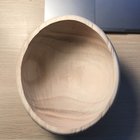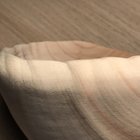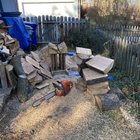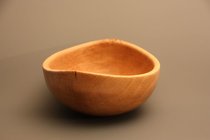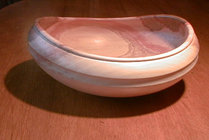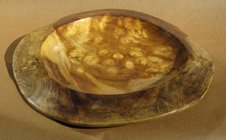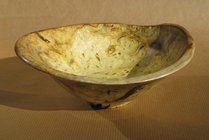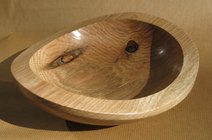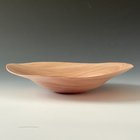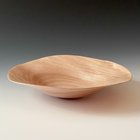Like the title says, I’m looking for your opinion/experience with n the most warpable wood. I have a project in mind where I’d like to use a species whose surface distorts visibly. Examples that come to mind are madrone burl and fig. Any others that give these a run for their money? Thanks all!
-
It's time to cast your vote in the December 2025 Turning Challenge. (click here for details) -
Congratulations to Pat White for "Sicilian Mosaic" being selected as Turning of the Week for December 29, 2025 (click here for details) -
Welcome new registering member. Your username must be your real First and Last name (for example: John Doe). "Screen names" and "handles" are not allowed and your registration will be deleted if you don't use your real name. Also, do not use all caps nor all lower case.
You are using an out of date browser. It may not display this or other websites correctly.
You should upgrade or use an alternative browser.
You should upgrade or use an alternative browser.
Most warpable wood?
- Thread starter Michael Anderson
- Start date
Eucalyptus warps like crazy.
For example it will drop 1/8" between growth rings. I turned a 6" diameter bowl which is now about 5" on the narrow side.
For example it will drop 1/8" between growth rings. I turned a 6" diameter bowl which is now about 5" on the narrow side.
Thanks David. That’s pretty intense!
On the plus side, it's really hard when it's dry 
Straight grain Madrone wood.
Eucalyptus wood. Live Oak. Almond wood.
Eucalyptus wood. Live Oak. Almond wood.
Oh wow, David. That is some nice rippling at the rim!
Thanks Hugh for the list. I would have never guessed live oak and almond.
Thanks Hugh for the list. I would have never guessed live oak and almond.
I have four 12" diameter x 12" long logs of it... not sure what I'm going to do with it yet because it warps so much.
Oh man, I’m jealous. I wish it feasible to do a log trade with you!
Shipping.... oh my!Oh man, I’m jealous. I wish it feasible to do a log trade with you!
Apple wood warps a lot. Its one of the few green woods I've turned that warped enough to notice while I was turning it.Like the title says, I’m looking for your opinion/experience with n the most warpable wood. I have a project in mind where I’d like to use a species whose surface distorts visibly. Examples that come to mind are madrone burl and fig. Any others that give these a run for their money? Thanks all!
It does seem quite stable once dry, though
Donna Banfield
TOTW Team
Other woods not already mentioned are woods that have significant difference in sap wood and heartwood.
For example, Cherry and Walnut. The difference in sapwood and heartwood in both of these species tends to lead to significant warping if the turned piece has a lot of sapwood. My experience in both woods has been to avoid more than 30% sapwood in rough turned bowl blanks, because the difference in density resulted in more failures; i..e., cracks because the sapwood lost moisture at a faster rate than the heartwood. Often the cracks didn't reveal themselves until I began second turning following 2-5 years of drying.
Currently, I will cut slabs of sapwood away from the bowl blanks and turn the sapwood pieces to final 'thinness', with the expectation that they will warp and move, which is exactly what I want. If I have a blank that is more than 30% sapwood compared to heartwood in either species, I will turn the blank to final 'thinness', which will fall between 1/8" to 3/16" and let it warp to whatever it desires.
For example, Cherry and Walnut. The difference in sapwood and heartwood in both of these species tends to lead to significant warping if the turned piece has a lot of sapwood. My experience in both woods has been to avoid more than 30% sapwood in rough turned bowl blanks, because the difference in density resulted in more failures; i..e., cracks because the sapwood lost moisture at a faster rate than the heartwood. Often the cracks didn't reveal themselves until I began second turning following 2-5 years of drying.
Currently, I will cut slabs of sapwood away from the bowl blanks and turn the sapwood pieces to final 'thinness', with the expectation that they will warp and move, which is exactly what I want. If I have a blank that is more than 30% sapwood compared to heartwood in either species, I will turn the blank to final 'thinness', which will fall between 1/8" to 3/16" and let it warp to whatever it desires.
quarter sawn sycamore will shrink and warp in multiple directions and not just oval.
- Joined
- Apr 27, 2004
- Messages
- 9,309
- Likes
- 6,081
- Location
- Lakeland, Florida
- Website
- www.hockenberywoodturning.com
Have only turned a few pieces of madrone it warps the most of the woods I have turned
These little pots about 5” diameter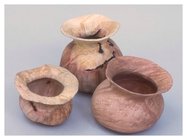
Some sycamore warps a lot too
The center of this form was a nice round ball when turned.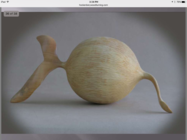
These screen shots of the dry sycamore bowl I turn in a demo show how oval it got.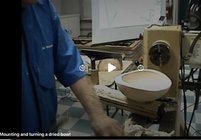
Made a nice demo and when the hollowing begins there is a huge difference in wall thickness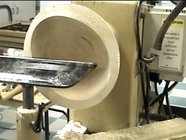
These little pots about 5” diameter

Some sycamore warps a lot too
The center of this form was a nice round ball when turned.

These screen shots of the dry sycamore bowl I turn in a demo show how oval it got.

Made a nice demo and when the hollowing begins there is a huge difference in wall thickness

Mike A, is it possible to do your own warping (?) by wetting the wood and force the distortion?
Bob and Chris, thanks for the recommendations. Apple is one wood I’ve not turned but I’ve wanted to for a while. And noted re. quartersawn sycamore.
Donna, thanks for the information. I’ve definitely noticed that cherry warps more when sapwood is included. Interesting generalization—I will keep that in mind.
Al, thanks for the images. That sycamore piece looks like it feels amazing. The madrone vessels are really nice too. That’s the warping I am most interested in, the obvious surface distortion. Looks like front two have burl included, and the back one is just sapwood and heartwood?
Glenn, thanks for the comment. That’s a possibility, but ideally I’d be able to turn thin green, and let it warp naturally. If the effect was obvious but subtle, then I would probably go your route to force more distortion.
Donna, thanks for the information. I’ve definitely noticed that cherry warps more when sapwood is included. Interesting generalization—I will keep that in mind.
Al, thanks for the images. That sycamore piece looks like it feels amazing. The madrone vessels are really nice too. That’s the warping I am most interested in, the obvious surface distortion. Looks like front two have burl included, and the back one is just sapwood and heartwood?
Glenn, thanks for the comment. That’s a possibility, but ideally I’d be able to turn thin green, and let it warp naturally. If the effect was obvious but subtle, then I would probably go your route to force more distortion.
- Joined
- Apr 27, 2004
- Messages
- 9,309
- Likes
- 6,081
- Location
- Lakeland, Florida
- Website
- www.hockenberywoodturning.com
Mike A, is it possible to do your own warping (?) by wetting the wood and force the distortion?
Steam bending is the most common technique for doing this. Michael Hosulak does a great demo where he turns a ladle and steam bends the handle.
Johannes Michelson uses some large clamps and rubber bands to increase the warp on some of his hats.
Somebody also steam warps long narrow wood, for example chairs, in a long plastic bag or tube.
- Joined
- Apr 27, 2004
- Messages
- 9,309
- Likes
- 6,081
- Location
- Lakeland, Florida
- Website
- www.hockenberywoodturning.com
That’s a possibility, but ideally I’d be able to turn thin green, and let it warp naturally. If the effect was obvious but subtle, then I would probably go your route to force more distortion.
Thin endgrain discs will warp a lot because the outer rings push inner rings outward.
Pascaul Oudet’s work is worth a look

Pascal Oudet on Instagram: "New work, #oak, turned and sandblasted. 28.5*26.5 cm Nouvelle création, #chene. #finecraft #metiersdart #wood #woodturning #sculpture #art #black #shadow #handmade #madeinfrance"
Pascal Oudet shared a post on Instagram: "New work, #oak, turned and sandblasted. 28.5*26.5 cm Nouvelle création, #chene. #finecraft #metiersdart #wood #woodturning #sculpture #art #black #shadow #handmade #madeinfrance". Follow their account to see 623 posts.
 www.instagram.com
www.instagram.com
A crotch turned thin warps in odd ways because of the opposite directions of the grain.
NE bowls the side wall come down and the bottom center pops up.
Burl surfaces often warp with ripples in the surface. If they are sanded wet then dry the surface is spectacular.
Unbalanced grain will give uneven warp.
I strive to balance grain to get even warp and symmetrical grain patters.
Sounds like you want the uneven look
- Joined
- Jul 18, 2018
- Messages
- 1,353
- Likes
- 2,932
- Location
- Baltimore, MD
- Website
- loujacobswoodturning.com
Thanks for this wisdom Donna. I just finished slabbing my recently harvested cherry logs. They are about 13” in diameter. I’ll be careful to take your advice and trim off most of the sapwood in favor of having less warping between rough and second turning.For example, Cherry and Walnut. The difference in sapwood and heartwood in both of these species tends to lead to significant warping if the turned piece has a lot of sapwood. My experience in both woods has been to avoid more than 30% sapwood in rough turned bowl blanks, because the difference in density resulted in more failures; i..e., cracks because the sapwood lost moisture at a faster rate than the heartwood. Often the cracks didn't reveal themselves until I began second turning following 2-5 years of drying.
Attachments
Pascaul Oudet’s work is worth a look
Burl surfaces often warp with ripples in the surface. If they are sanded wet then dry the surface is spectacular.
I strive to balance grain to get even warp and symmetrical grain patters.
Sounds like you want the uneven look
Thanks Al. Pascal’s work is great. I think he recently turned a 3’ diameter oak disc with fantastic movement!
Ripples in the surface is ideal for my plan this time. I’m not concerned with an even look—the more random the better. Why do you recommend wet sanding and THEN dry sanding?
- Joined
- Apr 27, 2004
- Messages
- 9,309
- Likes
- 6,081
- Location
- Lakeland, Florida
- Website
- www.hockenberywoodturning.com
No! I either worded it poorly or you misinterpreted.Ripples in the surface is ideal for my plan this time. I’m not concerned with an even look—the more random the better. Why do you recommend wet sanding and THEN dry sanding?
Since it’s the season to be jolly let’s go with I worded poorly
You cannot sand after it dries or you sand off the ripples.
This is where you sand wet. Abranet does well
You see the ripples in these madrone pieces. They aren’t sanded wet madrone cuts so cleanly I skipped that.
I did a little hand sanding with 400 to knock off any fuzz feeling. The 400 doesn’t take much off the ridges.
You can see a tool mark at the widest spot on the bottom right one….
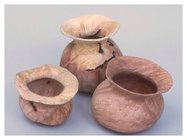
The thing I like about madrone is that I find it almost impossible to predict how each piece will warp. Things to consider for getting a 3 D surface: I like spring harvested wood because the tree has more water in it. Any 'compression' or tension wood will tend to have more figure in it and will give you more surface texture. So a branch growing horizontally, the buttress part of the tree at the base, the part of the tree under where a big branch comes into the main trunk, crotch wood. As for species warpage, the higher the water content of the tree, like madrone and sycamore, the more movement you will get as the wood loses water. Unfortunately we don't get much black cherry out here. I have 3 planted on my property, and if I am still turning 30 years from now, I may harvest one....
robo hippy
robo hippy
Ha! We’ll say it was a team effort. Okay, that makes sense. I thought you were on to some special madrone-specific process haha.No! I either worded it poorly or you misinterpreted.
Since it’s the season to be jolly let’s go with I worded poorly.
Reed, thanks for the response. That’s good to know about seasonal harvest movement. I’ve thought some about that might affect things, but don’t have enough experience yet to make sense of it all on the lathe. I happily trade you some black cherry for madrone. I have loads of it here. If only that was a possibility haha
- Joined
- Feb 6, 2010
- Messages
- 3,466
- Likes
- 2,536
- Location
- Brandon, MS
- Website
- threeringswoodshop.square.site
john lucas
AAW Forum Expert
Wysteria vine warps a huge amount but it's hard to find in larger sizes. I was lucky enough to find some 16" in diameter. Even leaving the walls of a bowl 1 1/2" thick it warped so bad you couldnt put it back on the lathe. Had to hand carve those bowls. The downside is it changes color from a beautiful green to an ugly brown as UV light gets to it.
Michael, I hope to get some madrone logs this spring. My log guy had a yard full of myrtle last year, but no madrone.... You might have to remind me.... I still have one big myrtle log, but the chainsaw is in the shop for a tune up....
robo hippy
robo hippy
@Gerald Lawrence thats interesting about the live oak surface. I used to live in San Antonio where it was fairly common. Will have to keep my eyes out for some here in TN
@john lucas thanks for the information. Wow, that’s a big piece of wisteria you scored! Admittedly, it’s not a variety I ever considered for turning. I looked up some photos—the color and grain is pretty stunning! I can definitely see how it would move a lot!
@robo hippy i will try to remember to remind you. That’s cool about the myrtle too—yet another wood that’s much more common on the west coast. Greener grass or something like that, haha. Also appreciate the Christian Burchard mention in the other thread—I was unfamiliar with his work. Really wild stuff! The book series, holy moly.
@john lucas thanks for the information. Wow, that’s a big piece of wisteria you scored! Admittedly, it’s not a variety I ever considered for turning. I looked up some photos—the color and grain is pretty stunning! I can definitely see how it would move a lot!
@robo hippy i will try to remember to remind you. That’s cool about the myrtle too—yet another wood that’s much more common on the west coast. Greener grass or something like that, haha. Also appreciate the Christian Burchard mention in the other thread—I was unfamiliar with his work. Really wild stuff! The book series, holy moly.
Michael here is a file of the shrinkage of domestic wood, (I know not every type of wood is in it).
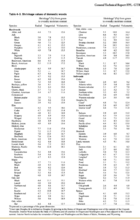 ,
,
I've learned that the type of wood is not always the deciding factor in the shrinkage and therefore the warpage of turnings, the shape of the turning can make a lot of difference between one piece over another of the same wood.
By choosing where you cut the wood out of a log you can get more or less warpage, like this Canadian Plum piece I got that came from the junction of root and stem, it shifted dramatically.
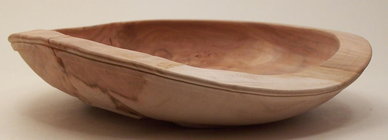
Some turners tell us that their wood did warp a lot while I find this not the case, and wonder what triggered their outcome.
Here are two Sycamore turnings that I turned from green and let dry, as you can see there is next to no shifting, by cutting the HF wood from one side of the log and the form I gave it, did make for a stable piece.
The other piece with the bark on also never changed shape, not sure why it stayed as turned.
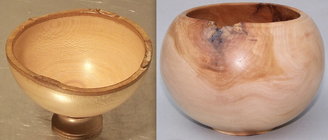
 ,
,I've learned that the type of wood is not always the deciding factor in the shrinkage and therefore the warpage of turnings, the shape of the turning can make a lot of difference between one piece over another of the same wood.
By choosing where you cut the wood out of a log you can get more or less warpage, like this Canadian Plum piece I got that came from the junction of root and stem, it shifted dramatically.

Some turners tell us that their wood did warp a lot while I find this not the case, and wonder what triggered their outcome.
Here are two Sycamore turnings that I turned from green and let dry, as you can see there is next to no shifting, by cutting the HF wood from one side of the log and the form I gave it, did make for a stable piece.
The other piece with the bark on also never changed shape, not sure why it stayed as turned.

OK following on the above reply to warpage and shrinkage, as I realized that with the 4 picture restriction, I would be over the limit with my pictures that shows the outcome of shape and chosen part of the tree to the after affect of that choice.
Here are two Black Walnut bowls that react the same as to where the blanks was taken from the log and turned a similar shape.
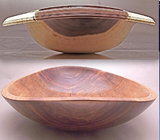
Next two Elmwood turnings where the platter like piece shows the amount of shrinkage and the other one the reaction to me placing the knot into one side of the turning and creating the extra twisting of that shape.
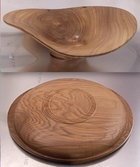
Next are two pieces that show the typical amount of shrinkage of those woods, top one is American Beech and below that Mulberry.
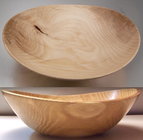
Now for Applewood bowls that I normally twice turn but for this bread bowl I turned 23 years ago, once turned and left to dry in my regular way, top picture is when new and shows the color of the wood while the second one shows the changes that have happened.
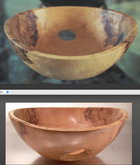
The lessons I learned are that one can influence the warpage of a turned wood by shape and place where you take the wood out of a log, and with or without knots and where you will place them by choosing the cuts you make.
Here are two Black Walnut bowls that react the same as to where the blanks was taken from the log and turned a similar shape.

Next two Elmwood turnings where the platter like piece shows the amount of shrinkage and the other one the reaction to me placing the knot into one side of the turning and creating the extra twisting of that shape.

Next are two pieces that show the typical amount of shrinkage of those woods, top one is American Beech and below that Mulberry.

Now for Applewood bowls that I normally twice turn but for this bread bowl I turned 23 years ago, once turned and left to dry in my regular way, top picture is when new and shows the color of the wood while the second one shows the changes that have happened.

The lessons I learned are that one can influence the warpage of a turned wood by shape and place where you take the wood out of a log, and with or without knots and where you will place them by choosing the cuts you make.
Cherry laurel is another wood that warps badly. Had some several years ago.Turns nicely, cream colored but rapidly turned orange exposed to air which probably faded to brown at some point.
Brings to mind comments I have gotten at shows.... "How'd you carve that thing out like that? You couldn't have done it on a lathe because it ain't round!"
robo hippy
robo hippy
The shape you gave it is the biggest reason IMO why it did warp the way it did, turning a flat platter will show more twist than a HF of the same wood.I’ve gotten interesting results from thin-turned sycamore.
Yes it is interesting to see how wood reacts to the drying tensions that are created with just the moisture moving out in faster and slower speeds
Blue oak warps like a star trek engine
John, I’ve never worked with Blue Oak before; to be honest I’m not really familiar with it either. Looked it up— very cool oak!
Darrell, that’s a beautiful bowl. Nice movement and color.
Gary, interesting you say cherry Laurel. Several months ago I came across a good section of cherry Laurel. Only about 3-4” diameter, but I actually like the orange color. Pretty interesting it shifts from the creamy color so quickly. It’s surprisingly dense too—I haven’t actually turned any donor yet, but am excited to. I think I may use it for little spirit pots, as Ellsworth calls them.
Leo, thanks for the couple of detailed posts. I appreciate the images from you, as usual. The chart is very helpful as well. You make a very good point, that warpage can be exaggerated or motivated based on shape and grain orientation. My intention for part of the project is to make a small vase form, about as deep as wide. 4x4ish, with the grain running diagonally, and maybe a couple of knots in the wall.
Neil, I actually dreamt about a nice piece of mulberry burl last night haha. Irish strawberry looks beautiful too—I’ve not heard of that before.
Darrell, that’s a beautiful bowl. Nice movement and color.
Gary, interesting you say cherry Laurel. Several months ago I came across a good section of cherry Laurel. Only about 3-4” diameter, but I actually like the orange color. Pretty interesting it shifts from the creamy color so quickly. It’s surprisingly dense too—I haven’t actually turned any donor yet, but am excited to. I think I may use it for little spirit pots, as Ellsworth calls them.
Leo, thanks for the couple of detailed posts. I appreciate the images from you, as usual. The chart is very helpful as well. You make a very good point, that warpage can be exaggerated or motivated based on shape and grain orientation. My intention for part of the project is to make a small vase form, about as deep as wide. 4x4ish, with the grain running diagonally, and maybe a couple of knots in the wall.
Neil, I actually dreamt about a nice piece of mulberry burl last night haha. Irish strawberry looks beautiful too—I’ve not heard of that before.
Any freshly dug up root will do amazing things if turned and finished while green. It is clearly the most unpleasant way to get turning wood.

